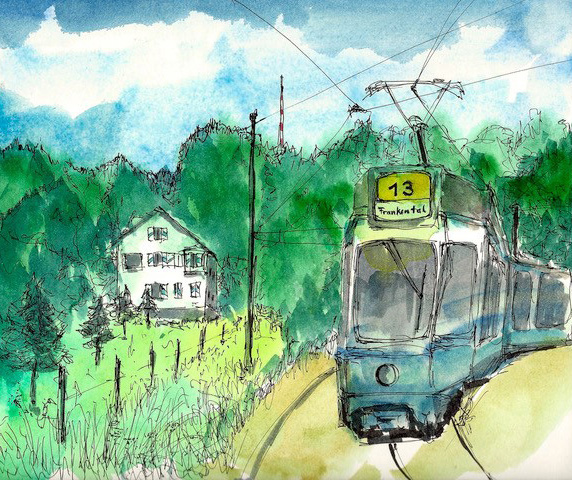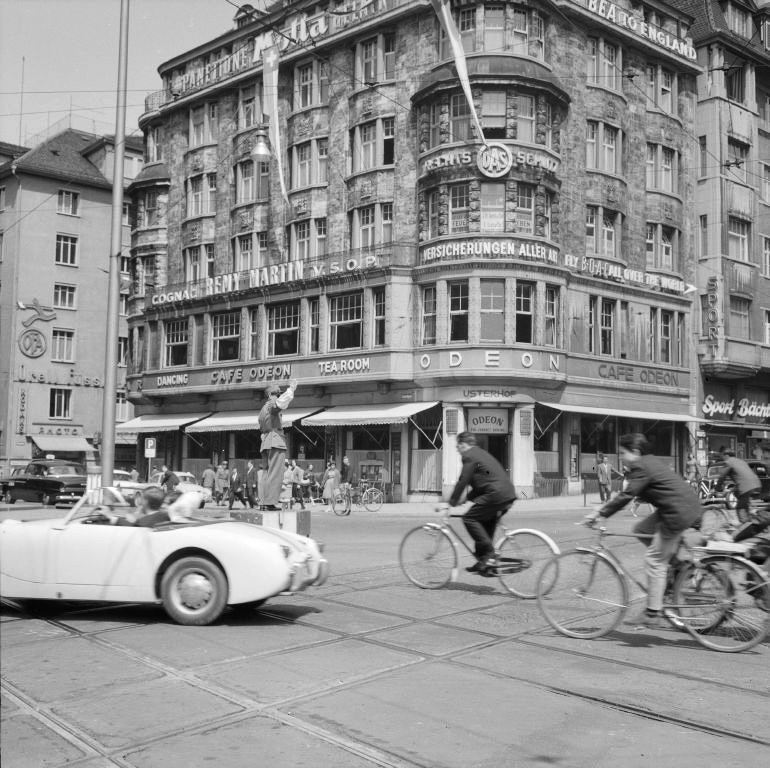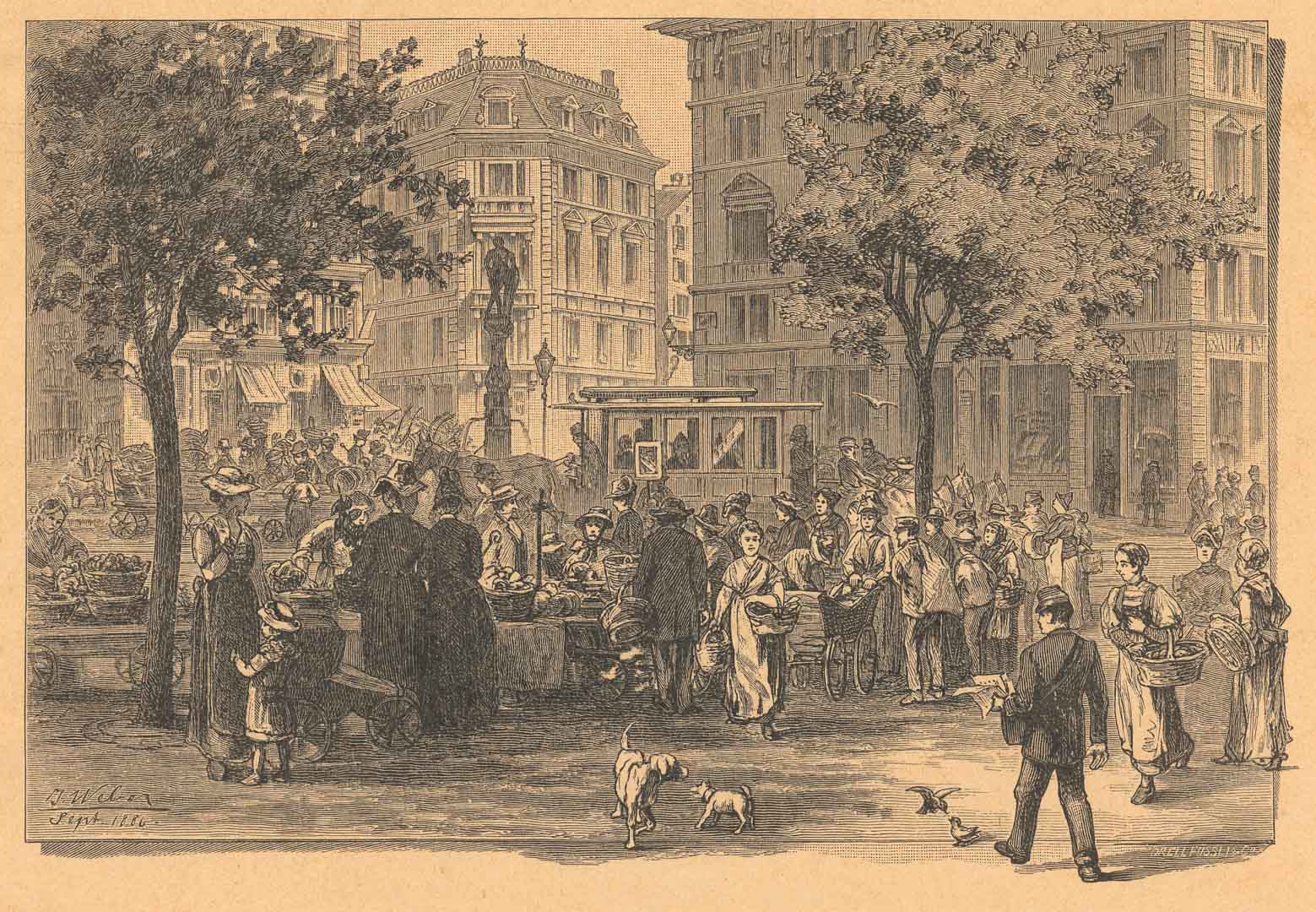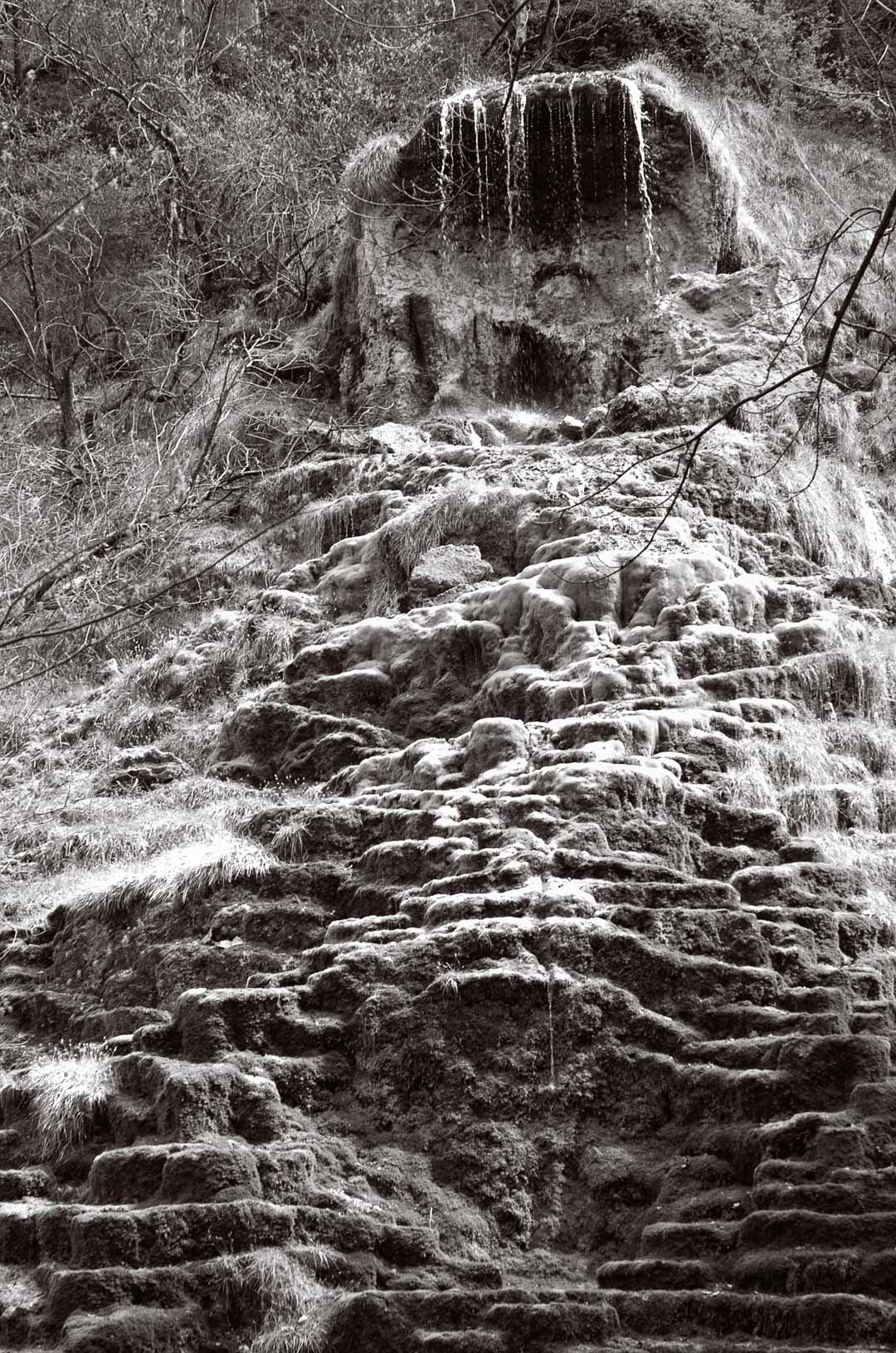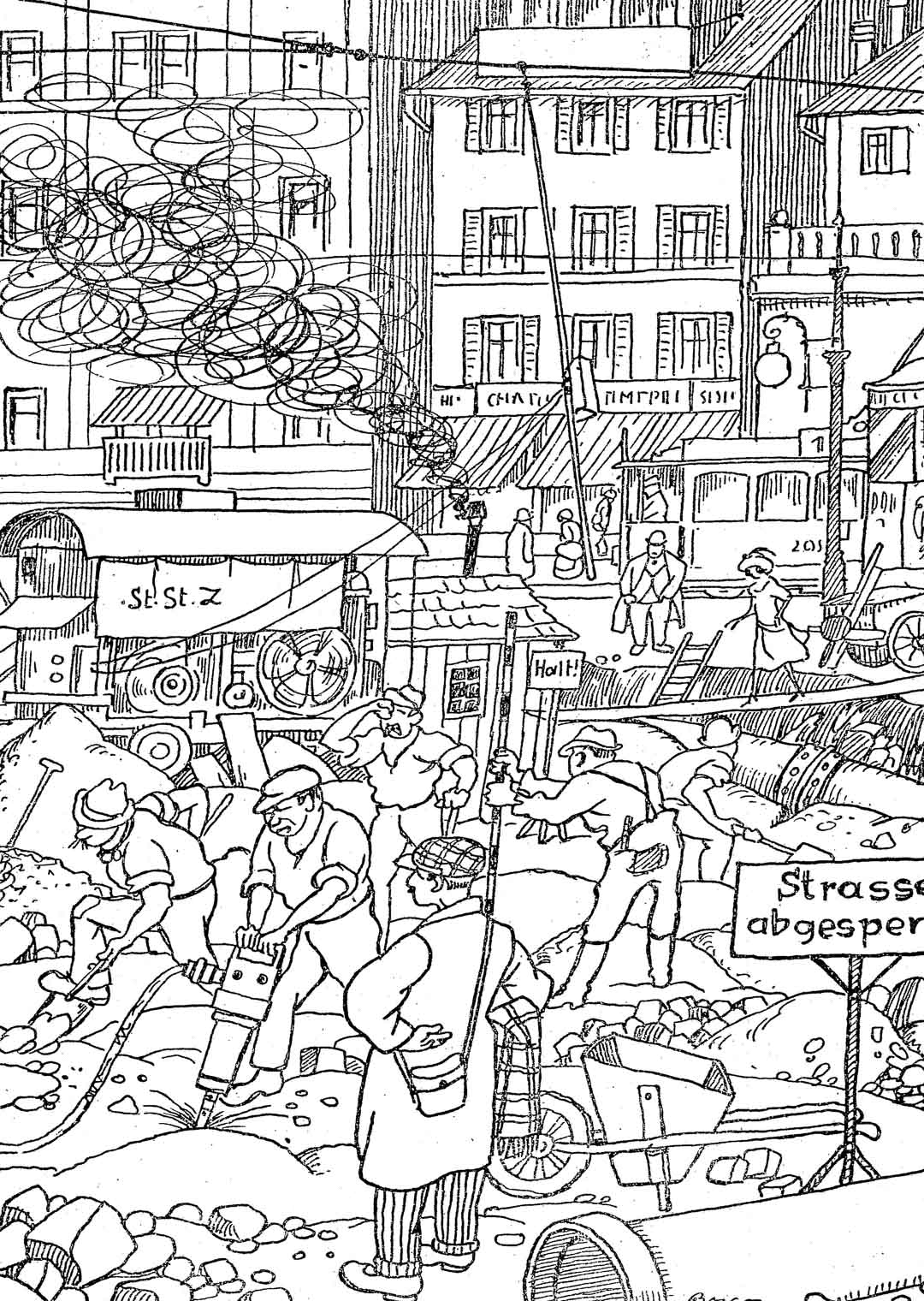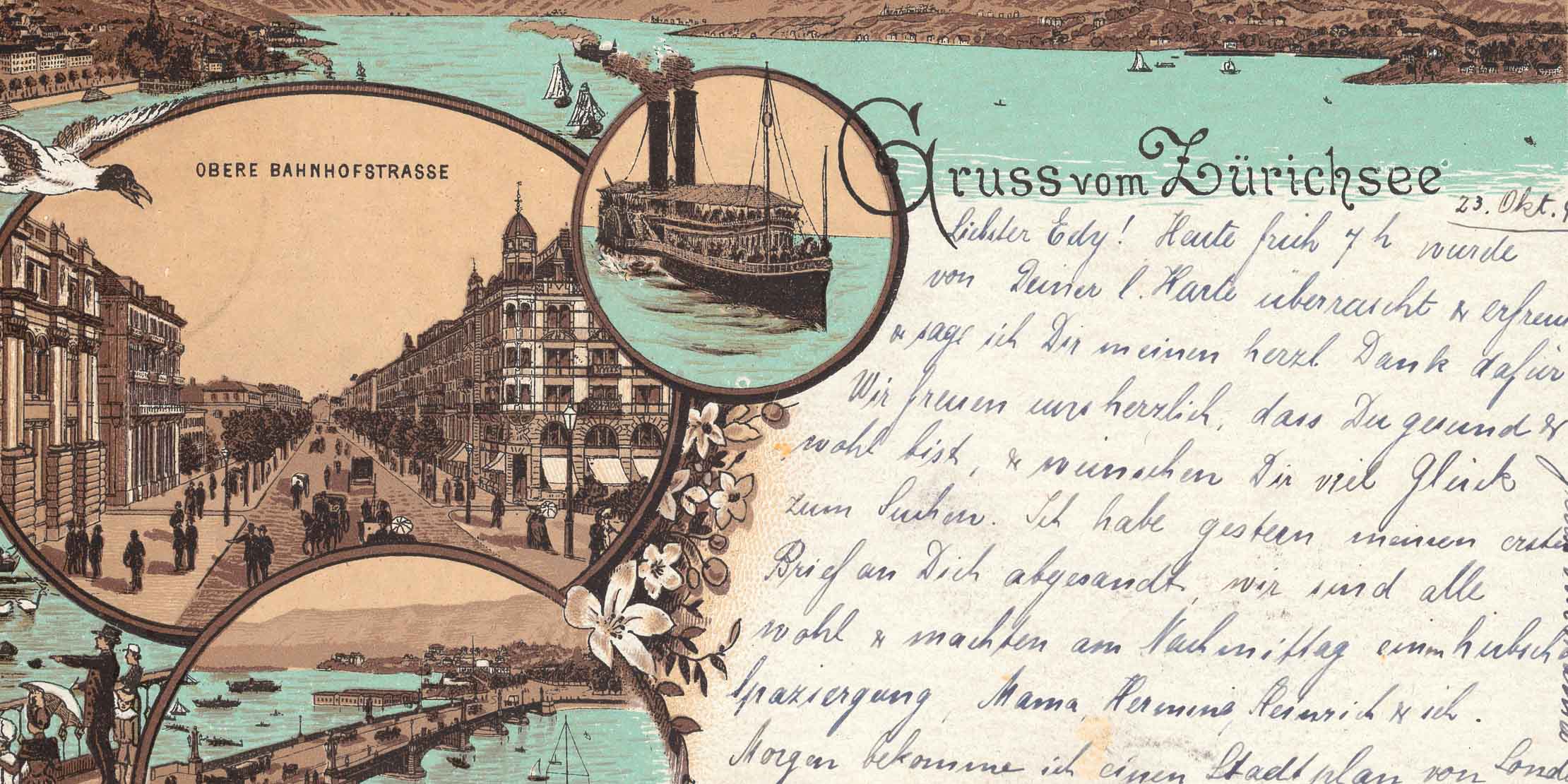
Holidays in Zurich
Why go abroad when you can stay at home? There is plenty to explore right outside the door, or even without leaving the sofa. We present some guides to Zurich from our holdings.
A feast for the eyes – artistic guides
On 16 August 1954, Zurich tram no. 13 makes its first run on its present-day route from Frankental to Albisgütli. The line numbers have finally reached 13, which many associate with bad luck. Nevertheless, it is “introduced without hesitation”.
The route passes through the village of Höngg, with its vineyards, on via Wipkingen and the industrial district into the city centre, through Paradeplatz and out to the terminus at the other end. Why not hop on board?
Gerd Folkers’s sketchbook “Linie 13” is full of superb illustrations depicting the various stops on the route’s journey through the city.
More artistic guides:
- “Zürich zu Fuss durch Stadt und Land: Wanderungen zu botanischen, kulturellen, kulinarischen und landschaftlichen Höhepunkten” – hand-written and lovingly designed by Hannes Stricker
- “Zürcher Spaziergänge: von Strassen und Plätzen, Häusern und alten Quartieren” – with illustrations by Zurich artist Hanny Fries
- “Zürich, das Buch einer Stadt: mit einem kleinen unpedantischen Lexikon zürcherischer Menschen und Sachen” – a gem from 1959 published by Artemis-Verlag, with wonderful black-and-white photographs
“Zürich du mein blaues Wunder” – a literary guide
Zurich is a literary city and has long attracted literary figures from far and wide. In the 18th and 19th centuries, it is a stopping-off point on the classic educational “Grand Tour” to Italy. In times of crisis, it has frequently become a place of refuge for writers. Many famous authors have written their works in Zurich.
Discover the city and its literary locations and enclaves through stories, poems and photographs. The roll call of those who have spent time in Zurich – often just on a short visit – is nothing short of remarkable.
A few selected literary guides to Zurich:
- Zürich zum Verweilen – editor André Gstettenhofer takes us on a tour of 17 literary sites, with extracts from novels, poems and stories
- “Nackt gebadet, gejauchzt bis zwölf: Weltliteratur in Zürich – 50 Porträts” – Martin Ebel’s series of articles from the Tages-Anzeiger newspaper in book form. A homage to Zurich and literature
- “Zürich: eine literarische Zeitreise” – fascinating biographies, touching tales. On the trail of writers in Zurich
- “‘Zürich, du mein blaues Wunder’: literarische Streifzüge durch eine europäische Kulturstadt” – a classic literary guide by Ute Kröger. The author continues her literary perambulations in the follow-up “‘Nirgends Sünde, nirgends Laster’”,
- “Auf den Spuren der Literatur: poetische Wanderungen in und um Zürich” – was published recently and will soon be available in our Turicensia Lounge
Exploring Zurich on foot
Father and son duo Ueli and Michel Brunner have explored many of Zurich’s ravines and published the walking guide “Wasserwunder: 22 verwunschene Tobelwanderungen im Kanton Zürich”. Their love of unspoilt nature is captured in large-format photographs.
The relatively easy walks, many of which are suitable for children and seniors, guide readers to a total of 50 ravines. The list of waterfalls at the end of the book includes “additional ravines” that can only be accessed via rougher paths less suited to the casual walker.
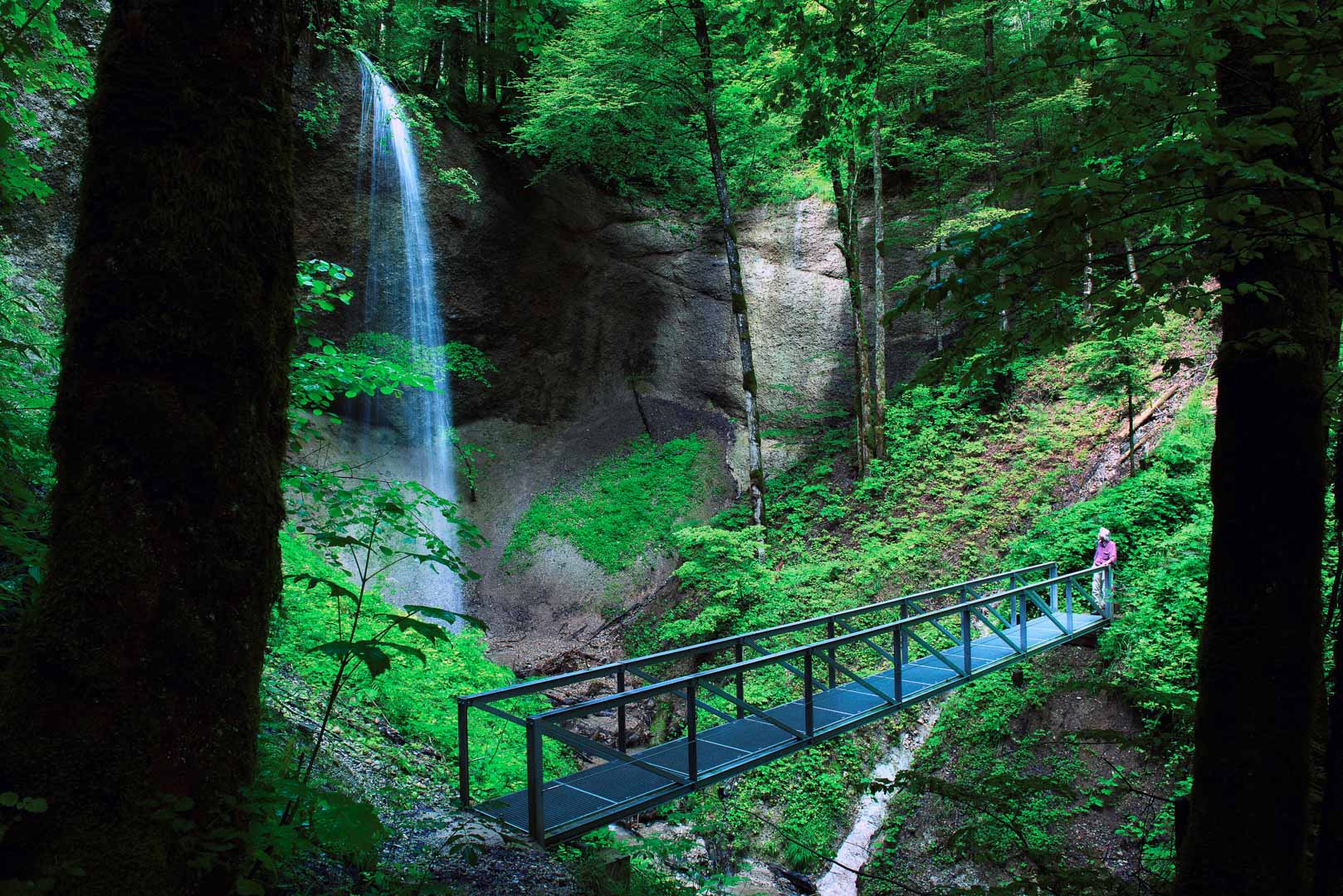
More Zurich walks:
- “Zürich, Zürichsee: 50 Touren” – a classic walking guide with a removable tour map
- “Wandern in der Stadt Zürich” – discovering the city on foot
Back to the future – historical guides
The people of Zurich are “often accused of frivolity and a rather too carefree attitude, compared with other Swiss folk”, notes “Zürich und seine Umgebung”, a 19th-century guide to the city and surrounding area. “The profusion of hostelries and places of entertainment, the frequent festivities and the insistence on using every free moment to set up an association demonstrate that the accusation is not entirely without foundation.”
The guide is part of the “Europäische Wanderbilder” series published by Orell Füssli over a period of almost 50 years starting in 1876. Other volumes guide tourists to the Uetliberg, the Au Peninsula and other locations in the canton of Zurich, Switzerland and Europe. Today, browsing through the handsome publications with their illustrations, photographs and texts is like going back in time.
More gems from our collection of Zurich travel guides:
- “Auf Wanderwegen rund um Zürich: von Endstation zu Endstation der Verkehrsbetriebe” – the legendary walking guide by Emil Erb
- “20 Zürcher Halbtagswanderungen” – published by the NZZ newspaper and “leisurely walking enthusiasts”
Heightened senses – Zurich’s power spots, myths and legends
Two farmers are complaining how small their plot of land in the commune of Hirzel is. When a devil offers them his assistance, they scoff at him: the devil is a tiny fellow and they refuse to believe he can help them. Insulted, he returns to his big brothers. Angered at the mockery he has endured, they raise the earth up with their shoulders, so creating the hills on the Hirzel.
This and other legends are retold by Barbara Hutzl-Ronge in her book “Magisches Zürich”. In all, 24 walks guide readers to power spots in the canton of Zurich, investigate their spiritual histories and conjure up visions of lost sacred sites.
More Zurich myths, legends and sacred sites:
- “Sagen und Legenden rund um den Zürichsee” – compiled by Peter Ziegler, arranged by locality
- “Geheimnisvolles Zürich: sakrale Stätten am Zürichsee” – myths and cult sites, narrated and described by a cultural anthropologist
Zurich’s funny side
“Not far from the emperor’s closed eyes on Zähringerplatz next to the Predigerkirche we find the new Central Library, in which we can entertain ourselves royally until the rain stops, even if it were to continue for eight days, which of course does not happen here.”
This quotation comes from the travel guide “Das moderne Zürich: ein Führer mit Humor durch die Stadt und Umgebung”, published in 1925. Do you recognise the Zurich of today from the description? Drawings by Fritz Boscovits and amusing advertisements take us back to the old days.
Other humorous guides:
- “Das i in Zürich: ein Touri-Guide” – a guide to the city in cartoon form
- “Zürich für Ausserirdische” – following a crash landing, Wampi and Schlampi take an adventure-packed tour of the city. A cartoon tour of Zurich
More guidebook highlights
- “Zürich: Spaziergänge durch 500 Jahre überraschende Stadtgeschichte”
- “Zürcher Liebesgeschichten: ein Stadtführer der besonderen Art”
- “Schauplätze: der Verein Frauenstadtrundgang Winterthur inszeniert Geschichte(n)”
- “Glücksorte in Zürich: fahr hin und werd glücklich”
- “Miis Züri: neun Streifzüge durch Zürich für Frauen”
- “Fred & Otto unterwegs in Zürich: Stadtführer für Hunde”
- “Stadtcafés mit Flair: eine genussvolle Entdeckungsreise durch die Kaffeeszene der Stadt Zürich”
Heidi Stieger and Stefanie Ehrler, Turicensia Department
April 2021
